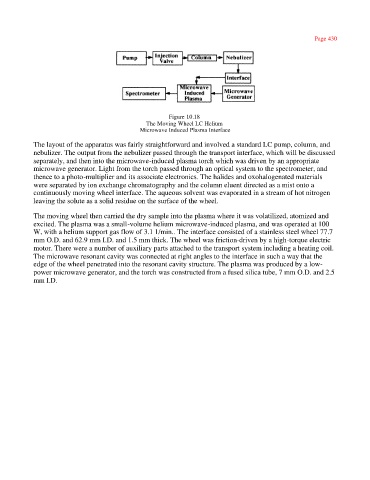Page 447 - Tandem Techniques
P. 447
Page 430
Figure 10.18
The Moving Wheel LC Helium
Microwave Induced Plasma Interface
The layout of the apparatus was fairly straightforward and involved a standard LC pump, column, and
nebulizer. The output from the nebulizer passed through the transport interface, which will be discussed
separately, and then into the microwave-induced plasma torch which was driven by an appropriate
microwave generator. Light from the torch passed through an optical system to the spectrometer, and
thence to a photo-multiplier and its associate electronics. The halides and oxohalogenated materials
were separated by ion exchange chromatography and the column eluent directed as a mist onto a
continuously moving wheel interface. The aqueous solvent was evaporated in a stream of hot nitrogen
leaving the solute as a solid residue on the surface of the wheel.
The moving wheel then carried the dry sample into the plasma where it was volatilized, atomized and
excited. The plasma was a small-volume helium microwave-induced plasma, and was operated at 100
W, with a helium support gas flow of 3.1 1/min.. The interface consisted of a stainless steel wheel 77.7
mm O.D. and 62.9 mm I.D. and 1.5 mm thick. The wheel was friction-driven by a high-torque electric
motor. There were a number of auxiliary parts attached to the transport system including a heating coil.
The microwave resonant cavity was connected at right angles to the interface in such a way that the
edge of the wheel penetrated into the resonant cavity structure. The plasma was produced by a low-
power microwave generator, and the torch was constructed from a fused silica tube, 7 mm O.D. and 2.5
mm I.D.

